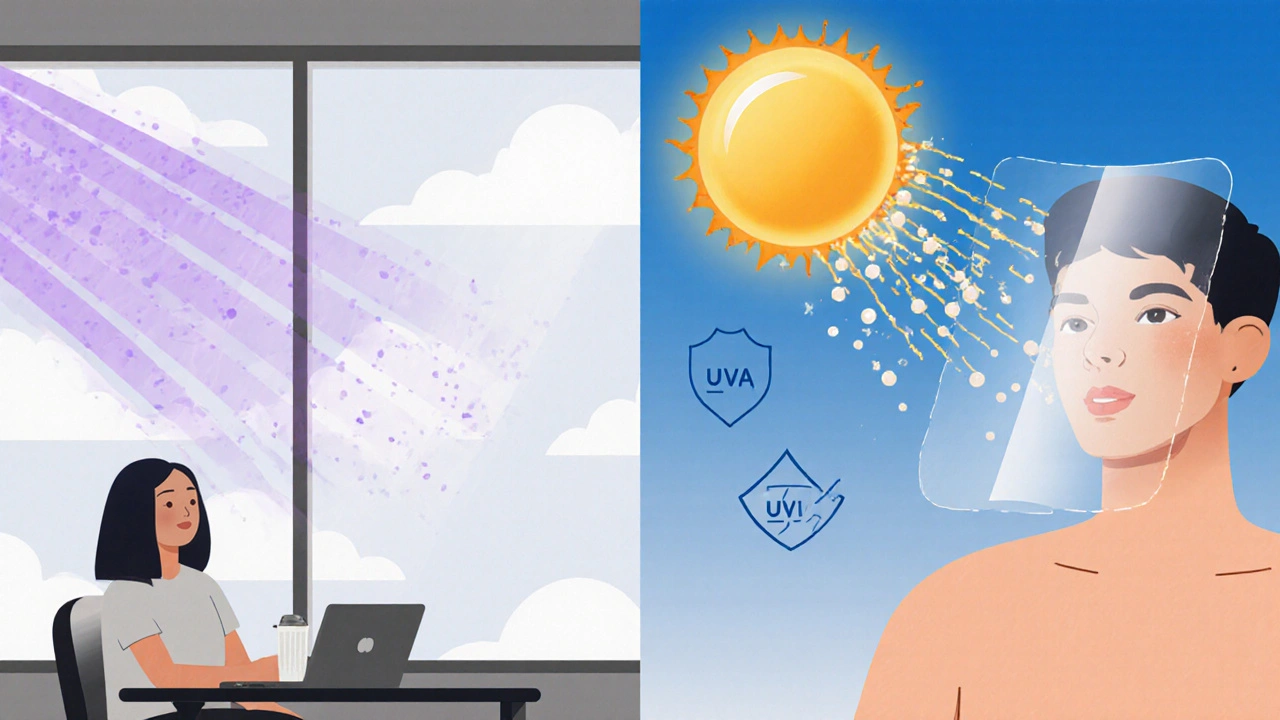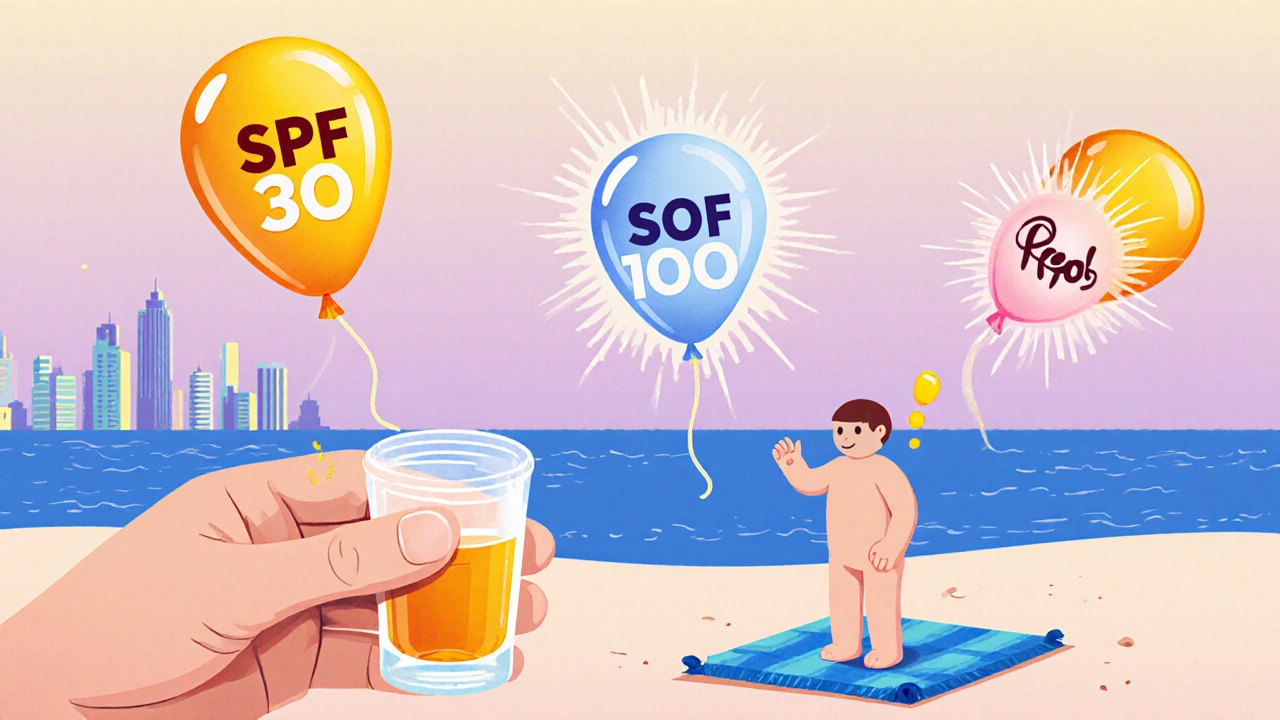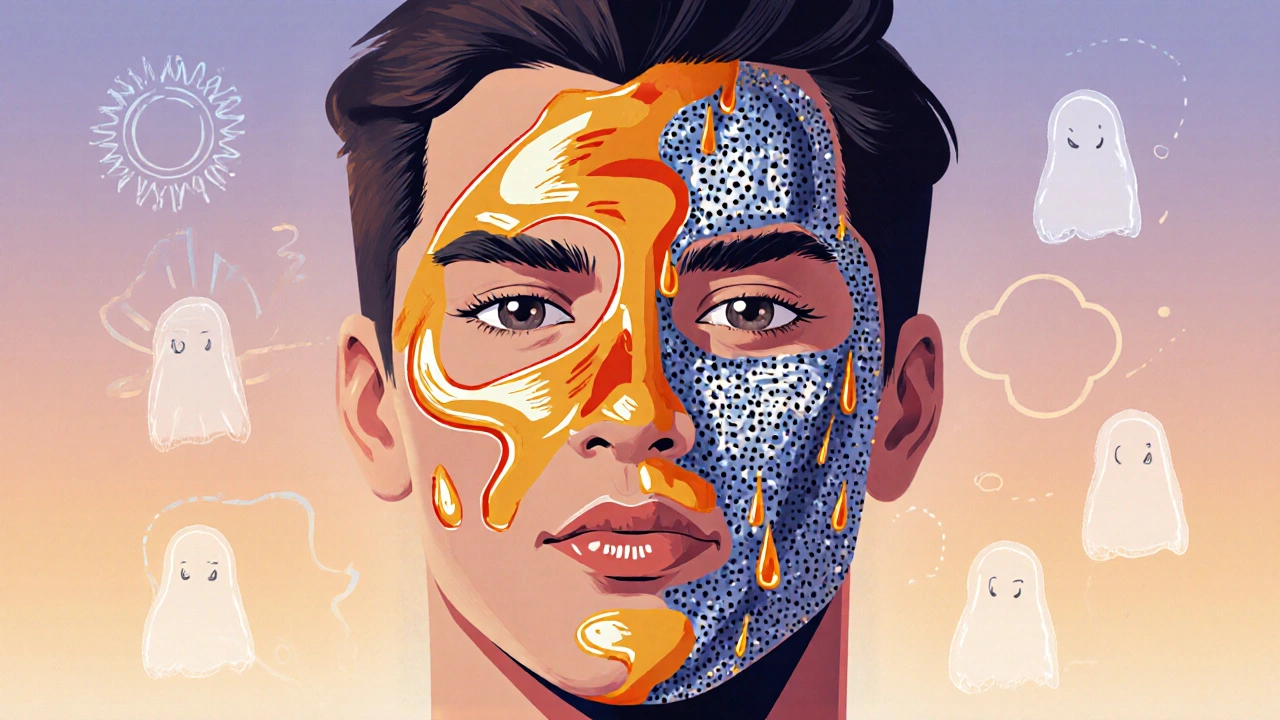Every morning, you grab your sunscreen. You squeeze it out, rub it on, and move on. But do you really know what you’re putting on your skin? And why does it matter so much-even on cloudy days or when you’re just running to the car?
The truth is, sunscreen isn’t just for beach days. It’s your number one defense against skin cancer and premature aging. And the science behind it is more precise-and more important-than most people realize.
What SPF Actually Means (And What It Doesn’t)
SPF stands for Sun Protection Factor. It tells you how long it takes for UVB rays to burn your skin when you’re wearing sunscreen compared to when you’re not. So if your skin normally burns in 10 minutes without protection, SPF 30 means it should take about 30 times longer-300 minutes-to burn.
But here’s the catch: that math only works if you apply the right amount. Most people use only a quarter to half of what they should. That means SPF 30 drops to SPF 7.5 or even SPF 15 in real life. Dermatologists say you need about a quarter teaspoon just for your face. For your whole body, it’s about an ounce-a shot glass full.
And SPF doesn’t tell the whole story. SPF only measures UVB protection. That’s the ray that gives you sunburn. But there’s another type of radiation doing silent damage every day: UVA.
UVA vs. UVB: The Invisible Enemy
UVB rays are the ones that burn. They’re strongest between 10 a.m. and 4 p.m., and they’re the main cause of skin cancers like melanoma and squamous cell carcinoma. But UVA rays? They’re sneakier.
UVA makes up 95% of the UV radiation that hits your skin. It penetrates deeper-past the top layer of skin, into the dermis where collagen and elastin live. That’s why it causes wrinkles, sagging, and dark spots. UVA doesn’t burn you. It doesn’t even make you feel like you’ve been in the sun. But it’s breaking down your skin’s structure, day after day.
And here’s the kicker: UVA rays are just as strong in winter, on cloudy days, and even through windows. If you sit by a window at work or drive a lot, you’re getting hit. That’s why dermatologists say daily sunscreen isn’t optional-it’s essential.
What “Broad Spectrum” Really Means
Look for those two words on the label: broad spectrum. That means the sunscreen protects against both UVA and UVB. But not all broad spectrum sunscreens are created equal.
In 2011, the FDA set rules: to be labeled broad spectrum, a sunscreen must pass a test called critical wavelength. It has to block UV rays up to at least 370 nanometers. And since 2023, the Skin Cancer Foundation updated its Seal of Recommendation to require proportional UVA protection. So if a sunscreen says SPF 50, its UVA protection must be strong enough to match that level-not just barely meet the minimum.
Here’s the math: SPF 15 blocks 93.3% of UVB. SPF 30 blocks 96.7%. SPF 50 blocks 98%. That’s not a huge jump from 30 to 50. But here’s why higher SPF still matters: most people underapply. So SPF 50 gives you a safety net. If you only put on half the amount, you’re still getting decent protection.

Mineral vs. Chemical: Which One Should You Use?
There are two main types of sunscreen: mineral and chemical. They work in completely different ways.
Mineral sunscreens use zinc oxide and titanium dioxide. These sit on top of your skin and reflect UV rays like tiny mirrors. They start working immediately. They’re less likely to irritate sensitive skin or cause breakouts. That’s why so many people with acne or rosacea swear by them.
But they have a downside: white cast. Especially on darker skin tones. That’s why brands like La Roche-Posay and CeraVe have spent years reformulating to make mineral sunscreens more cosmetically elegant. Some now use micronized particles that blend in better.
Chemical sunscreens use ingredients like avobenzone, octinoxate, and octocrylene. They absorb UV rays like a sponge, converting them into harmless heat. They tend to be lighter, easier to rub in, and leave no white residue. But they need about 15 minutes to activate after application. And some people react to them-itching, stinging, or breaking out.
Reddit users in r/SkincareAddiction report that 78% of those who switched from chemical to mineral sunscreens saw fewer breakouts. But 63% said the white cast was a dealbreaker. The best solution? Try a few different formulas. Look for ones labeled “sheer” or “tinted.”
Water Resistance, Reapplication, and Common Mistakes
Water resistance isn’t waterproof. No sunscreen is. The FDA only allows two labels: “water resistant (40 minutes)” or “water resistant (80 minutes).” That means after swimming or sweating, you need to reapply within that time frame-even if you didn’t towel off.
Reapplying every two hours is the rule. But most people forget. If you’re outside all day, set a phone reminder. If you’re wearing makeup, use a mineral powder sunscreen with SPF 30 or higher. You can reapply it over foundation without messing up your look.
Another mistake? Skipping your ears, neck, lips, and scalp. Your ears get skin cancer more than you think. Use a stick sunscreen for your lips. If you have thinning hair, part it and apply sunscreen to your scalp-or wear a hat.
And don’t forget: sunscreen can pill. That’s when it clumps up under makeup. The fix? Let it sit for 15 minutes after applying. Don’t rush. Let it absorb. Then apply moisturizer or foundation.

What’s Changing in 2025?
The FDA is tightening rules. By December 2025, any sunscreen sold in the U.S. must clearly show “broad spectrum” on the front label. If it doesn’t pass the test, it gets pulled from shelves.
Also, the maximum SPF you’ll see labeled is likely to be capped at SPF 60+. Why? Because above that, the extra protection is tiny. SPF 100 isn’t twice as good as SPF 50-it’s barely better. But people think it is. That leads to false confidence and worse application habits.
And the future? Dermatologists are already looking beyond UV. Blue light from screens and infrared radiation from the sun may also contribute to skin aging. Some new sunscreens now include antioxidants like vitamin C and ferulic acid to help fight those effects. Don’t expect them to be standard yet-but they’re coming.
What to Look for in a Daily Sunscreen
You don’t need the most expensive one. You need one you’ll actually use every day. Here’s what to check:
- SPF 30 or higher-minimum. SPF 50 is better if you’re outside often.
- Broad spectrum-non-negotiable.
- Mineral or chemical? Pick based on your skin. Sensitive? Try mineral. Oily skin? Look for oil-free chemical formulas.
- No oxybenzone or octinoxate if you’re worried about coral reefs or skin irritation.
- Water resistant if you sweat or swim.
- Non-comedogenic if you’re acne-prone.
Top brands that consistently meet these standards: La Roche-Posay Anthelios, CeraVe Hydrating Mineral Sunscreen, Neutrogena Sheer Zinc, and Suntribe. All have high ratings on Amazon and trusted by dermatologists.
Why This Isn’t Just About Skin Cancer
Skin cancer is the most preventable cancer. But sunscreen does more than save lives. It keeps your skin looking younger. Every day you skip it, you’re speeding up wrinkles, dark spots, and uneven tone. You’re not just protecting against burns-you’re protecting your skin’s structure.
In Perth, where the UV index regularly hits 12 or higher in summer, this isn’t theoretical. Even in winter, the UV level here is higher than in many tropical places. Daily protection isn’t a luxury. It’s a necessity.
Start today. Apply it every morning. Don’t wait for the sun to be strong. Don’t wait for a beach day. Just put it on. Like brushing your teeth. Your future self will thank you.
Do I need sunscreen on cloudy days?
Yes. Up to 80% of UV rays penetrate clouds. UVA rays, which cause aging and long-term damage, are just as strong on overcast days. Daily sunscreen is meant for everyday exposure-not just sunny beach days.
Is SPF 100 better than SPF 50?
Not significantly. SPF 50 blocks 98% of UVB rays. SPF 100 blocks 99%. That’s just a 1% difference. But people using SPF 100 often apply less, thinking they’re fully protected. That can backfire. SPF 30 to 50, applied properly, is all you need.
Can I use last year’s sunscreen?
Check the expiration date. Most sunscreens last 3 years unopened. Once opened, they’re good for about 12 months. If it’s changed color, smell, or texture, toss it. Expired sunscreen won’t protect you.
Do I need sunscreen if I have dark skin?
Yes. While darker skin has more natural melanin protection, it’s not immune to UV damage. Skin cancer is often diagnosed later in people of color, leading to worse outcomes. UVA damage-wrinkles, dark spots-also affects all skin tones. Broad spectrum sunscreen is essential for everyone.
Should I wear sunscreen indoors?
If you’re near a window, yes. UVA rays pass through glass. If you sit by a window all day at work or drive frequently, you’re getting daily exposure. A daily moisturizer with SPF 30 is enough for indoor use.
What’s the best sunscreen for acne-prone skin?
Look for oil-free, non-comedogenic chemical sunscreens with ingredients like octisalate or homosalate. Or try mineral sunscreens with zinc oxide that are labeled “for sensitive skin.” Avoid heavy, greasy formulas and those with oxybenzone, which can clog pores.
How much sunscreen should I use on my face?
About a quarter teaspoon-that’s the size of a nickel. Most people use half that, which cuts protection in half. For your face and neck together, aim for half a teaspoon.
Can I rely on makeup with SPF instead of sunscreen?
Not alone. Most people don’t apply enough foundation or powder to get the SPF listed on the label. Use sunscreen underneath. Makeup with SPF can be a helpful extra layer, but not your only defense.




doug schlenker on 27 November 2025, AT 14:53 PM
Been using mineral sunscreen for years after my face broke out from chemical ones. The white cast used to bug me until I found CeraVe’s tinted version-now it blends like a dream. I don’t even notice it’s on anymore.
Also, I apply it right after washing my face, before moisturizer. Let it sit for 10 minutes. No pilling, no greasy feel. Game changer.